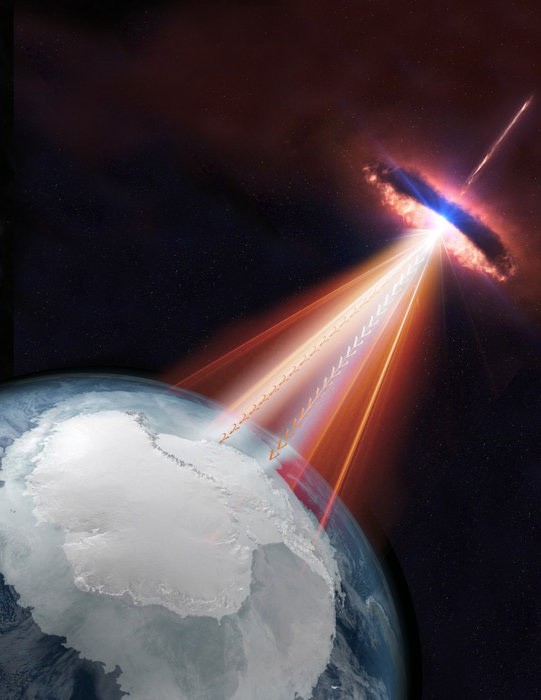Neutrino Astrophysics:Seeing the Quantum Universe
- 21 Aug 2019
- Volume 17
- NanoScientific Magazine, Summer 2019
NEUTRINOS ARE AMONG THE MOST ABUNDANT PARTICLES IN THE UNIVERSE, A BILLION TIMES MORE ABUNDANT THAN THE PARTICLES THAT MAKE UP STARS, PLANETS AND PEOPLE. NEUTRINOS ARE PRODUCED IN UNIMAGINABLE QUANTITIES BY THE SUN AND STARS. COULD THEY BE THE DARK MATTER THAT CONTROLS THE FATE OF THE UNIVERSE OR EXPLAIN WHY WE LIVE IN A UNIVERSE OF MATTER AND NOT ANTIMATTER? WORLDCLASS, MULTIPURPOSE DETECTORS DESIGNED TO SOLVE THE PUZZLE ABOUT NEUTRINOS ARE DISCUSSED IN THIS ARTICLE ALONG WITH FIRST HAND UPDATES FROM TWO OF THE PHYSICISTS WORKING IN THIS AREA. THE DETECTOR RESEARCH AIMS TO GET A CLEARER PICTURE OF THE UNIVERSE, CREATING A NEW ERA OF SCIENCE: NEUTRINO ASTROPHYSICS.
Super-Kamiokande is the large water Cherenkov detector located in Gifu Japan. The construction was started in 1991 and the observation began on April 1st, 1996
The Super-Kamiokande detector consists of a stainless-steel tank, 39.3m diameter and 41.4m tall, filled with 50,000 tons of ultra pure water. About 13,000 photomultipliers are installed on the tank wall. The detector is located at 1,000 meter underground in the Kamioka-mine, Hidacity, Gifu, Japan.
One of the purposes of the Super- Kamiokande experiment is to reveal the neutrino properties through the observation of solar neutrinos, atmospheric neutrinos and man-made neutrinos. In 1998, from the observation of atmospheric neutrinos we discovered the neutrino oscillations which neutrinos are changing their types in flight. In 2001, solar neutrino oscillations were discovered by the observation of solar neutrinos. In 2011, the third neutrino oscillation mode was discovered by manmade neutrino observation.
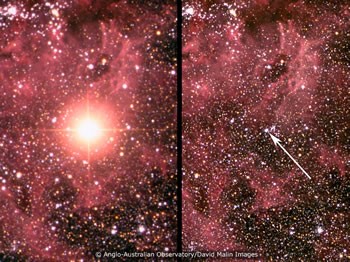
SUPERNOVA 1987A, WHICH OCCURRED ON FEBRUARY 23, 1987. THE RIGHT FIGURE SHOWS BEFORE EXPLOSION. (Anglo-Australian Observatory/ David Malin)
Neutrinos move at or very near the velocity of light, have no electric charge, and have so little mass that until very recently scientists were not sure if neutrinos have any mass at all. Until recently, when in 1988 neutrino oscillation was discovered by the Super-Kamiokande experiment.
A supernova explosion happens when a star at least 8 times more massive than the sun collapses. An enormous amount of energy (more than 99% of energy emitted from the Sun for 4.5 billion years) is released primarily in the form of neutrinos in just 10 seconds. A supernova explosion is expected to occur inside our galaxy once every 10 to 50 years. If such an explosion occurs, Super-Kamiokande is expected to detect about 8,000 neutrinos. and be able to reveal the mechanism of supernova explosions by analyzing the information of the energy and the arrival time of these neutrinos.
“SINCE NEUTRINOS INTERACT ONLY WEAKLY WITH MATTER THEY CAN BE USED TO INVESTIGATE BOTH THE DEEP INTERIOR OF STARS AND THE FAR REACHES OF THE UNIVERSE. FOR EXAMPLE, WE CAN OBSERVE NOT ONLY THE CORE OF OUR SUN, WHOSE NUCLEAR FUSION CREATES THE LIGHT THAT POWERS THE EARTH, BUT ALSO THE MOMENT WHEN THE CENTRAL CORE OF A MASSIVE STAR COLLAPSES AS A SUPERNOVA BURST USING THE NEUTRINOS THESE PROCESSES
CREATE.” DR. MASAYUKI NAKAHATA, DIRECTOR, SUPER-KAMIOKANDE COLLABORATION."
They pan to "dissolve gadolinium in the tank around the end of this year or the beginning of next yesr in order to enter a new phase of observation. "We candetect supernova neutrinos from the beginning of the universe, improve pointing accuracy for galactic supernova, reduce background for nucleon decay searches, and etc.," explains Dr. Nakahata.
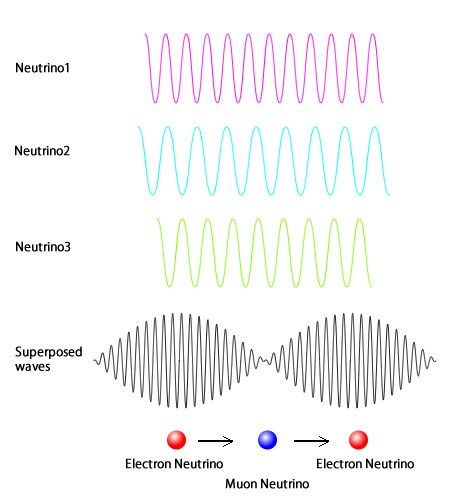
Pictured Neutrino oscillation was discovered by the Super-Kamiokande experiment in 1998.Neutrinos exhibit the properties of a as a wave. Therefore, neutrino1, neutrino2 and neutrino3, each with different mass eigenstates, travel through space as waves that frequency. The flavor of a neutrino is determined as a superposition of the mass eigenstates. The type of the flavor oscillates, because of the wave changes. This phenomenon is called neutrino oscillation. Neutrino oscillation occurs when neutrinos have mass and non-zero mixing.
The next phase in this project is the proposed Hyper-Kamiokande (HK), to be constructed in Kamioka, Hida City, Gifu Prefecture, expected to start sometime in 2020 with eight times larger fiducial mass than Super K.
Hyper K will be equipped with newly developed high-sensitivity photosensors. The aim of HK is to elucidate the Grand Unified Theory and the history of the evolution of the universe through an investigation of proton decay and CP violation (the difference between neutrinos and antineutrinos), as well as the observation of neutrinos form supernova explosions. Seed funing for Hyper Kamiokande(HK) has already been allocated for the current Japanese fiscal year, and 12 countries, including Japan, expressed interest in the project.
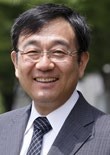
MASAYUKI NAKAHATA is the Director, Kamioka observatory, ICRR the University of Tokyo and Spokesperson for the Super-Kamiokande Collaboration in Gifu-ken, Japan. The Super-Kamiokande is operated by an international collaboration of about 150 people and about 40 institutes from Japan, the United States, China, Poland, Spain, Canada, UK, Korea, Italy and France.
In January, Super-K was restarted after work was done in 2018 to stop a water leak in the tank. "The very precise test done in early February showed that water leak is comletely fixed." explainde Dr. Nakahata, "We filled pure water to the tank from last October to January. In this time, we reciculated water even filling phase. Becasuse of this new scheme, water transparency has been very good even just after thetank was full and we have been taking good data in SK-V.”
AN INTERVIEW WITH DR. KATE SCHOLBERG
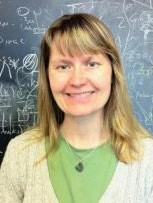
KATE SCHOLBERG is a Professor of Physics at Duke University where her broad research interests include experimental elementary particle physics, astrophysics and cosmology. Her main specific interests are in neutrino physics. Dr. Scholberg studies neutrino oscillations with the Super-Kamiokande experiment where her primary involvement is with the atmospheric neutrino data analysis, which in 1998 yielded the first convincing evidence for neutrino oscillation (implying the existence of non-zero neutrino mass).
Why do you think understanding Neutrinos is so important and how might it help us understand the universe? How is Neutrino research impacting physics?
Neutrinos are fundamental particles, like electrons and quarks, and we need to understand the properties of the fundamental constituents of matter if we are to understand the “big picture” of Nature. Neutrinos also played a role in the early Universe. It is very likely that neutrinos were important in the generation of matter at very early times in the Universe’s history. One of the huge questions out there is why we have an enormous excess of matter today, rather than antimatter, given that the properties of matter and antimatter are almost symmetric. Neutrinos were probably involved in the generation of the matter-antimatter imbalance. Therefore we need to understand the properties of neutrinos in order to figure out how the Universe became so matter-heavy.
Can you explain how SNEWS gathers information about Supernovas? And do you have any theory on when the next event might occur?

Deep Underground Neutrino Experiment (DUNE)
SNEWS (Supernova Early Warning System) is a network of large underground neutrino detectors. Any one of these detectors would see an intense burst of neutrinos within about 10 seconds if a star’s core collapses in the Milky Way. Any of the detectors, if they see such a burst, will send a datagram to the central
SNEWS computer. If this computer receives at least two datagrams indicating bursts within 10 seconds of each other, it sends out an alert message. Individual experiments, if they have really clean signals, can also send individual alerts, but two or more at the same time will mean we are sure that something happened.
Unfortunately the kind of core-collapse supernova burst that would result in a SNEWS alert is really rare— it will happen only about every 30 years or so in the Milky Way. We have no good way of predicting when or where it happens next, although we can keep an eye on some red giant stars, like Betelgeuse, which might blow up any minute (or 10,000 years from now-- it’s hard to tell for an individual star). Some stars, in the months and days before they blow up, may produce extra neutrinos, and we will be watching for that too, but such a presupernova neutrino signal would be so faint that we could only see it for very nearby stars (Betelgeuse is one of them). The rarity of such a stellar blowout
does mean that it’s especially important to be prepared, so that we can capture all possible information, in neutrinos, photons, and other astrophysical messengers, like gravitational waves.
Do you think the Hyper K proposal will be approved and why is it important?
It can be harder to make funding predictions than supernova ones! Hyper-K is certainly a good prospect. It will see a truly enormous number of neutrinos (actually, mostly antineutrinos) from a supernova. The Deep Underground Neutrino Experiment (DUNE) in the U.S. is also a good future prospect. It will see fewer neutrinos than Hyper-K, but because it’s made of argon rather than water, it will see mostly neutrinos, whereas Hyper-K will see antineutrinos. This will bring us unique information about, for example, the star’s collapse into a neutron star. JUNO in China is another future large detector, to be made of hydrocarbon, which will see antineutrinos. Deep Underground Neutrino Experiment (DUNE), will be the largest particle physics project ever to be built in the United States. Hosted by the U.S. Department of Energy’s Fermilab, this international project brings together more than 1,000 scientists from more than 30 countries around the world, all dedicated to unraveling the mysteries of ghostly particles called neutrinos. To do this, Fermilab will send its world-leading particle beam 800 miles (1,300 kilometers) through the earth to four gigantic detectors built a mile beneath the surface at the Sanford Underground Research Facility in South Dakota. A liquid-argon neutrino detector, pre-excavation work is in full swing at the site in Lead, South Dakota.
Can we create images of the Elusive Neutrinos Using AFM/SPM?
“Well, I think AFM, SEM, etc. won’t be of much use, I’m afraid,” says Dr. Scholberg “One cannot directly see a neutrino. What one does see is the tracks or other evidence of charged particles that result from the rare interaction of the neutrino with matter, and one can make images out of this information. There are a lot of different detector technologies. Usually the images are electronic: for example, the charged particles make Cherenkov light, and then photo sensors capture and digitize the photons, making lovely ring images. In other detectors, like DUNE (a “time projection chamber”), the charged particles from the interaction ionize liquid argon, and the ionization charge is drifted in a high electric field placed on the argon, and then collected to make an image in the projected shape of a track. The time at which the charge arrives on an anode plane gives the third dimension.
TWO SCIENTISTS FROM THE TANDEN SCHOOL OF ENGINEERING NEW YORK INTERESTED IN NEUTRINO MASS DETECTION USING AFM
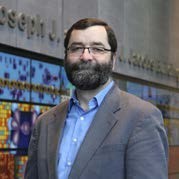
LORCAN M. FOLAN,
Department Chair, Applied Physics, NYU Tandon School of Engineering
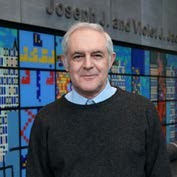
VLADIMIR TSIFRINOVICH
Industry Professor, Sr. Lecturer, Applied Physics, NYU Tandon School of Engineering
Their paper titled “Generation of a directed mono-energetic neutrino beam and measurement of the neutrino mass" was a proposal for a method to measure the rest mass of the neutrino emitted in electron capture beta decay. We study generation of a directional monoenergetic neutrino beam in electron capture beta-decay and analyze the recoil force exerted by neutrinos. We consider the influence of the neutrino rest mass on the recoil force and discuss the opportunity for neutrino mass measurement using an atomic force microscopy (AFM). We compute the enhancement of the signal-to-noise ratio due to signal accumulation (averaging), find the optimal time for signal accumulation and formulate conditions for measurement of neutrino mass with AFM.
“My collaborator, Vladimir Tsifrinovich and I are very interested in neutrinos. Of the fundamental particles, they are perhaps the most enigmatic. Subsequent work indicates that the sensitivity required to make a measurement is beyond current technology, but we are still working on finding a method that will work.” Lorcan M. Folan, Department Chair, Applied Physics, NYU Tandon School of Engineering. “Our opinion is that every proposal, including our AFM proposal, should be pursued further.”
Why is the Neutrino particle the most enigmatic of the fundamental particles?
According to the Standard Model neutrinos do not have rest mass. However oscillation experiments show that they do have a mass. Thus, neutrino is the only fundamental particle which cannot be described in the scope of the Standard Model. There are believed to be three neutrino types or flavors (electron, muon and tau) and three neutrino masses, but there is not a one to one correspondence between the flavors and the masses. And the mass ordering and
flavor mixings are still unknown.
Can you explain why the current technology was not capable of the image?
As the first step to the AFM neutrino mass experiment, one should detect the recoil force produced by neutrino radiation. In our proposal, a sample containing 5x10-10 kg of radioactive antimony atoms must be attached to an AFM tip in order to produce a 1 pN recoil force at a temperature of 25 mK. If this force could be detected, we could discuss the use of AFM for the neutrino mass measurement. So far, even this initial experiment has not been implemented.
What/how does technology need to advance to make this measurement?
We believe that the first step could be achieved with current AFM technology. If it is done, one will need to increase the sensitivity of the measurement in order to measure the neutrino mass.
Why is a method for this measurement important and is it possible for AFM (if improved) to make this measurement?
There are currently a few proposals for the neutrino mass measurement. None of them has succeeded. Our opinion is that every proposal, including our AFM proposal, should be pursued further.
How are discoveries about Neutrino likely to change physics as we understand it today? What do you think it might explain about the universe?
Discoveries about neutrinos could generate a new theory of baryonic matter beyond the standard model. It could also help to understand the mysterious dark matter and asymmetry between matter and antimatter in our Universe.
